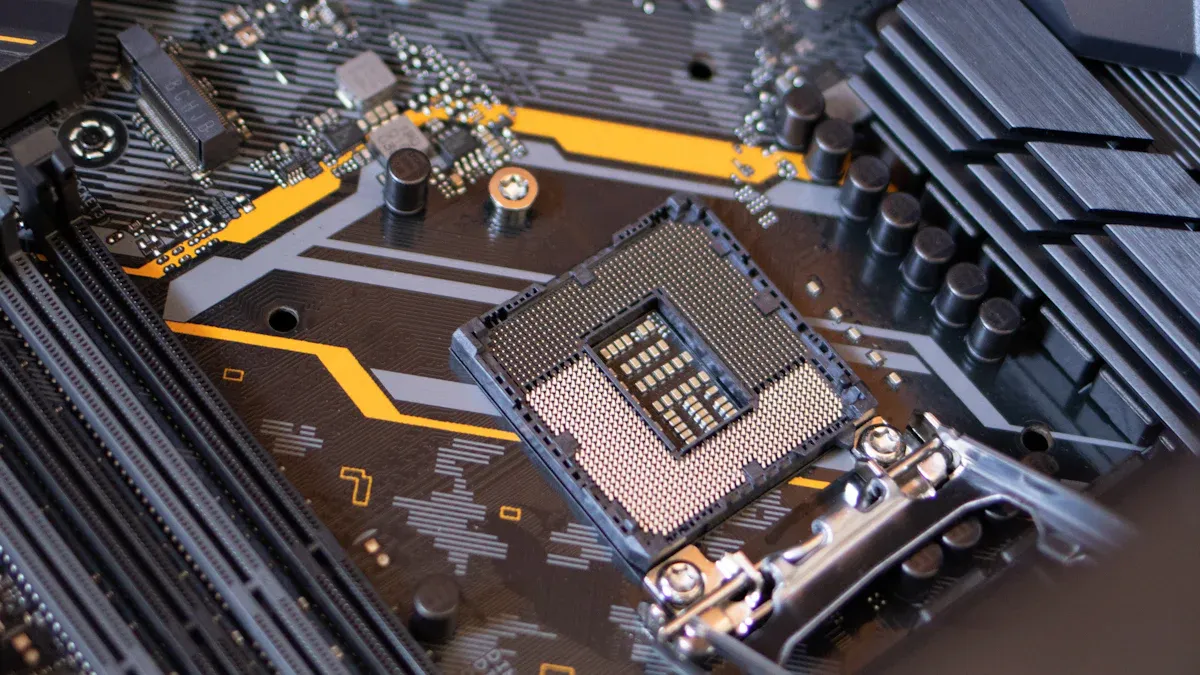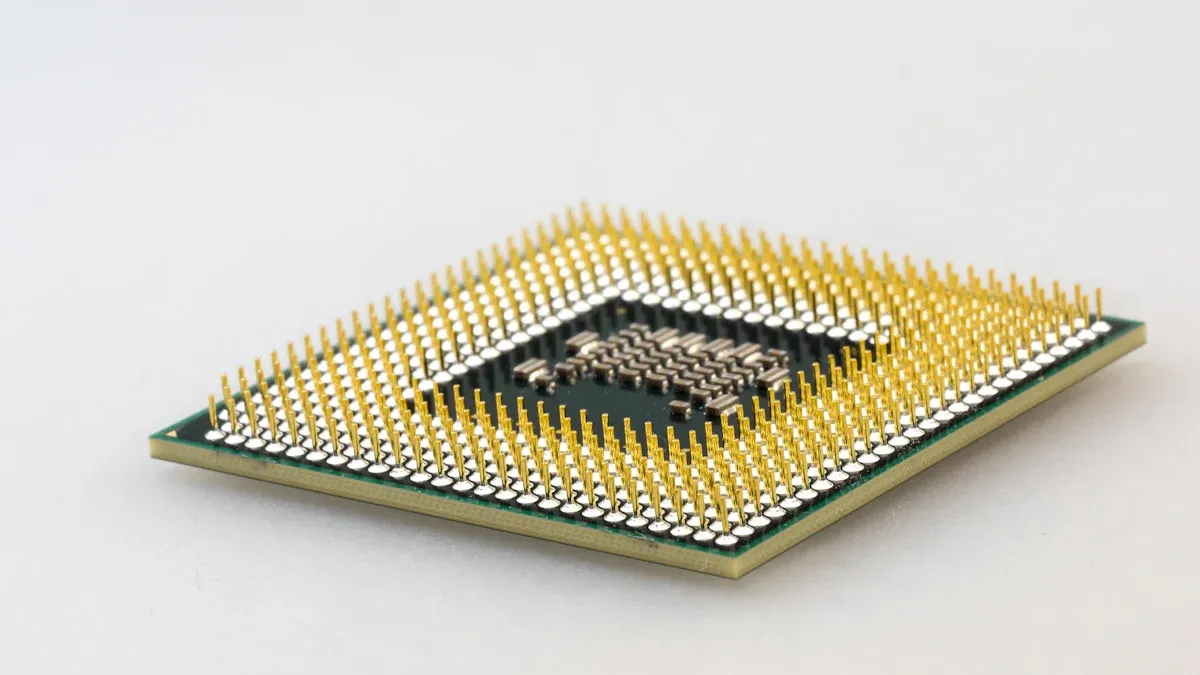Choosing Your STM32F030F4P6TR Distributor in 2025 A Comprehensive Guide

Selecting the right STM32F030F4P6TR distributor in 2025 is a critical decision. Your choice directly impacts project success, cost-efficiency, and supply chain stability. The microcontroller unit market projects to reach USD 36.23 Billion in 2025, underscoring the dynamic nature of this sector. This guide empowers you to navigate this market effectively. You will make strategic, informed decisions regarding authenticity, reliability, pricing, and technical support for your STM32F030F4P6TR needs.
Key Takeaways
Always check if your STM32F030F4P6TR parts are real. Fake parts can cause big problems for your project.
Choose distributors who can always deliver parts on time. Look at how much stock they have and how fast they ship.
Compare prices and payment plans from different distributors. This helps you get the best deal for your project.
Good distributors offer help with technical questions. They also provide services like managing your parts inventory.
Build strong relationships with your chosen distributors. This helps ensure you get the parts you need when you need them.
2025 STM32F030F4P6TR Market Landscape

Market Dynamics and Supply Outlook
You will navigate a dynamic semiconductor market in 2025. This market projects to reach $697 billion in sales. It continues strong momentum from 2024. The industry remains on track for $1 trillion by 2030. Generative AI accelerator chips are a primary growth driver. These chips are for PCs, smartphones, and enterprise edge devices. Their sales could surpass $150 billion in 2025. Advanced packaging technologies also fuel this growth.
However, you must consider potential challenges. Geopolitical tensions, especially between the US and China, reshape global trade. This prompts increased investments in reshoring and diversification. Building robust supply chains is crucial. The industry also faces talent shortages and cybersecurity concerns. Despite these challenges, AI adoption for efficiency in production, R&D, and supply chain management is increasing. This market landscape directly impacts the availability and procurement of components like the STM32F030F4P6TR.
Authorized vs. Independent Distributors
You face a fundamental choice when sourcing components: authorized or independent distributors. Authorized distributors have formal agreements with Original Component Manufacturers (OCMs). They source products directly from the OCM. This ensures authenticity and provides direct access to manufacturer resources and support. You will find common and easy-to-find parts through them. They offer a lower risk of counterfeit parts.
Independent distributors are not tied to specific manufacturers. They source from multiple suppliers. This gives them a broader product range. They often provide hard-to-find or obsolete parts. However, this sourcing method introduces a higher risk of counterfeit components. You may also find they lack direct manufacturer support. Purchasing from unvetted independent vendors carries risks. You could lose money or receive fake parts. Sending order lists to too many independent distributors can also inflate demand. This leads to significant price increases. To mitigate this, you should purchase through trusted suppliers. You can also verify supplier legitimacy against OCM websites.
Evaluating STM32F030F4P6TR Distributors

You must carefully evaluate potential distributors. This ensures you secure reliable and authentic components. Your project's success depends on this thorough assessment.
Authenticity and Traceability
Verifying component authenticity is paramount. You must avoid counterfeit parts. Counterfeits can lead to project failures and significant financial losses. Always demand manufacturer certifications and traceability documentation. This documentation confirms the origin and journey of your STM32F030F4P6TR. Reputable distributors provide full transparency. They offer detailed batch numbers, date codes, and factory seals. These details allow you to trace the component back to its original manufacturer.
Supply Reliability and Inventory
Assess a distributor's ability to consistently supply the STM32F030F4P6TR. Look at their lead times and stock levels. You need a partner who can manage potential disruptions effectively.
Consider typical lead times for the STM32F030F4P6TR:
Quantity (pieces) | Lead time (days) |
|---|---|
1 | |
51 - 100 | 3 |
> 100 | To be negotiated |
Distributors employ several strategies to manage supply chain disruptions:
Diversifying the Supplier Base: They avoid over-reliance on a single supplier or region. This mitigates significant risks.
Strengthening Existing Relationships: They collaborate closely with suppliers. This involves managing forecasts, lead times, and inventory strategies.
Proactively Managing Multiple Tiers of Suppliers: They gain visibility into secondary and tertiary suppliers. This helps identify weak points early.
Leveraging Open Market Distributors: These distributors source parts from various channels. This flexibility helps meet demand for hard-to-find parts.
Implementing Stringent Quality Control and Counterfeit Mitigation: Reputable open market distributors use comprehensive inspections. They employ testing protocols like X-ray inspection and decapsulation. This ensures component integrity.
Utilizing AI and Predictive Analytics: AI helps forecast demand and optimize inventory. It identifies patterns and predicts shortages.
Adopting Blockchain Technology: Blockchain offers enhanced transparency and traceability. It verifies component authenticity.
Focusing on Supply Chain Resilience: Distributors invest in strategies to enhance resilience. They diversify sourcing channels and manage risks.
Pricing and Payment Terms
Compare pricing structures from different distributors. Look beyond the unit cost. Consider the total cost of ownership. This includes shipping, handling, and potential tariffs. Evaluate the payment terms offered. Distributors often offer terms like net-30.
Faster payment equals lower risk for you. Smart companies incentivize early or upfront payments with better pricing.
Distributors may offer discounts for shorter payment terms. This encourages early payment. A comprehensive evaluation includes payment terms and extended financing options.
Technical Support and Services
A distributor's technical support can be invaluable. They offer expertise and assistance with product selection and troubleshooting. Top-tier distributors provide various value-added services:
Sourcing: They find original electronic components with low prices and fast delivery.
Cost Savings: They help OEMs, ODMs, and CMs meet savings targets.
Inventory Management: They offer data-driven models, excess mitigation, and product lifecycle management.
Strict Quality Control: They maintain high quality standards in component testing.
Product Lifecycle Management: They safeguard against supply chain disruptions from obsolescence.
Shortages and Hard-to-Find Support: Experienced teams and large inventories help find needed parts quickly.
Same-day shipping: Some, like Digi-Key, are known for quick delivery for urgent prototyping.
New product introductions: Mouser Electronics often lists the latest ICs and MCUs first.
Logistics and IoT integration: Arrow focuses on these areas.
Cloud and embedded system support: Avnet offers superior support here.
Robust tools: Digi-Key and Arrow provide tools for BOM management and supply forecasting.
Logistics and Shipping
Efficient logistics are crucial for timely delivery. Evaluate a distributor's shipping options and delivery times. A delayed delivery can halt your production. For example, TechXpress, a leading electronic distribution company, experienced a production stoppage. This was due to delayed delivery of a microcontroller imported from China. This logistics issue caused lost sales revenue and increased costs.
Review standard international shipping options:
Service Name | Transit Times | Key Features |
|---|---|---|
1-3 business days | Time-definite international shipping for urgent shipments. | |
DHL Express 9:00 | 1-2 business days (by 9:00 AM) | Early morning delivery for extremely urgent international shipments. |
DHL Express 12:00 | 1-2 business days (by 12:00 PM) | Noon delivery for urgent international shipments. |
DHL Economy Select | 3-5 business days | Cost-effective option for less urgent international shipments. |
Service Name | Delivery Timeframe | Key Features |
|---|---|---|
1-3 business days, typically by 10:00 a.m. or 11:30 a.m. | Early morning delivery for urgent shipments to select countries. | |
FedEx International Priority® | 1-3 business days, typically by end of day | Time-definite delivery for urgent shipments to over 220 countries. |
FedEx International Economy® | 2-5 business days, typically by end of day | Cost-effective option for less urgent international shipments. |
Service Name | Delivery Timeframe |
|---|---|
Next business day by 8:00 a.m. to major cities in Canada and Europe. | |
UPS Worldwide Express® | Next business day to Canada and Mexico. One to three business days to Europe and Asia. |
UPS Worldwide Saver® | Next business day to Canada and Mexico. One to three business days to Europe and Asia. |
UPS Worldwide Expedited® | Two to five business days to over 220 countries and territories. |
Reputation and Customer Reviews
A distributor's reputation reflects their reliability and service quality. Look for key indicators of a reputable electronic component distributor:
Global Operations: They have testing facilities and operations worldwide.
Certifications and Memberships: Look for ISO 9001, AS9120, AS6081, and ERAI membership.
Strong Procurement Controls: They have detailed vendor qualification and management processes.
Rigorous Quality Inspection: They use multi-phase, multi-point inspection to ensure authenticity.
Advanced Facilities and Equipment: They invest in equipment like chemical Decap and X-Ray.
Robust Security Measures: They implement data and physical security.
Knowledgeable Employees: Staff are well-trained on the latest techniques.
Transparent Communication: They have clear processes for sharing inspection results.
Market Intelligence: They monitor market events and provide supply chain updates.
You can find customer reviews and ratings on platforms like Trustpilot. Many distributors, including Worldway Electronics Limited, WIN SOURCE ELECTRONICS, Utmel, and YIC International Co., Limited, have reviews there. These reviews offer insights into other customers' experiences.
Selecting Your Distributor
Define Project Needs
You must first assess your project's specific demands. This happens before you engage with any distributors. Consider the STM32F030F4P6TR microcontroller's specifications. These include its 48 MHz Arm Cortex-M0 core. It has up to 256 KB Flash memory and up to 32 KB SRAM. The operating range is -40 to +85°C at 2.4-3.6V. You also need to consider specific voltage range and power consumption needs. Various package types exist, such as 20-pin, 64-pin, or 20-TSSOP. Define your required communication interfaces, like I2Cs, SPIs, or USARTs. Also, note any needs for its 12-bit ADC or seven 16-bit timers.
Research and Shortlist Potential Distributors
Next, identify reputable distributors. You can start by researching well-known suppliers. Examples include DigiKey or Rantle. These companies are known suppliers of the STM32F030F4P6TR. Look for distributors with a strong track record. Check their reputation for quality and service.
Request Quotes and Compare Offers
After shortlisting, request detailed quotes. Compare offers from different distributors. Look at unit pricing, shipping costs, and lead times. Evaluate any additional fees or services.
Due Diligence and Verification
Perform thorough due diligence. Verify a distributor's financial stability and operational capacity. Request financial statements like balance sheets and income statements. Analyze their debt-to-equity ratio. Examine their cash flow. These steps help you understand their ability to meet commitments. Ensure they comply with regulations. Check for quality management system certifications. Verify their product quality control processes.
Communication and Relationships
Foster strong, long-term partnerships. Establish clear expectations and goals upfront. This minimizes misunderstandings. Create an environment for open dialogue. Both parties should feel comfortable sharing feedback. Schedule regular meetings with key vendors. Share your business plans and forecasts. This transparency helps them plan effectively. It reduces lead times and prevents stockouts.
Making an informed decision about your STM32F030F4P6TR distributor in 2025 is paramount for project success. You must prioritize authenticity, reliability, pricing, and robust technical support. Conduct thorough due diligence on potential partners. Foster strong, long-term relationships. Apply these outlined strategies. You will confidently and efficiently secure your critical component needs. This ensures your projects thrive.
FAQ
What is the most important factor when choosing an STM32F030F4P6TR distributor?
Authenticity is paramount. You must ensure your components are genuine. Counterfeit parts lead to project failure. Always demand manufacturer certifications. Verify traceability documentation. This confirms the component's origin.
How can you ensure supply reliability for the STM32F030F4P6TR?
You should assess a distributor's inventory levels. Look at their typical lead times. Ask about their strategies for managing disruptions. Diversifying your supplier base also helps. This ensures consistent component availability.
Should you choose an authorized or independent distributor?
Authorized distributors offer guaranteed authenticity. They source directly from manufacturers. Independent distributors provide broader product ranges. They often have hard-to-find parts. You face a higher counterfeit risk with independent sources. Always vet independent distributors carefully.
What kind of technical support should you expect?
Expect comprehensive support. A good distributor offers product selection help. They assist with troubleshooting. Look for value-added services. These include inventory management and quality control. Some provide same-day shipping for urgent needs.
See Also
Selecting the Optimal Low-Power Microcontroller for Your Next Project
The Best Synchronous Buck Converter Chips to Consider for 2025
A Comprehensive Comparison of Leading FPGA Development Boards Available Now
Finding Reliable Analog Devices Authorized Distributors for Your 2025 Needs
Discover the Ten Best Microcontrollers for Embedded Systems in 2025
